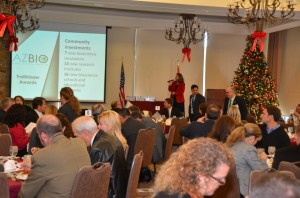It’s that time of year. The time when we look back at what has been done, plan for what is yet to come, gather our partners around to say thanks, and engage in new projects for the year ahead.
Progress:
2012 here, but before we say adieu to 2011 let’s look back at the progress we made as together we moved forward faster.
Moving Forward FASTER was our theme for 2011 as we expanded media and social media outreach with EmpowHER, launched the new AZBio.org and AZBio1 YouTube Channel. Thanks to the hard work and efforts of the AZBIo events committee and our AZBio support team at KCA over 600 members of our community gathered together at our AZBio Signature events, the AZBio Awards and Expo and the 2011 Trailblazer Awards to celebrate award winning companies and leaders who are driving their teams forward faster and making it possible for all of us to join them.
Partnerships with the Flinn Foundation, the Arizona Commerce Authority, The Arizona Technology Council, Medtronic, ATIC and GPEC resulted in events that highlighted the progress we are making together across the state.
- April’s Road Map Update and Legislative Meet and Greet at the Arizona Science Center
- June’s Arizona Pavilion at the BIO International Convention in Washington, D.C.
- July’s Partnering Conference with the Arizona Technology Council
- September’s Medtronic Open House and ATIC/AZBio Conference on TeleHealth
- October’s AZBio Awards and Expo
- November’s Collaborating for Customized Care (GPEC Personalized Medicine Summit)
- December’s Trailblazer Awards
There are hundreds of photos on Facebook – to find yourself and your friends – click here
While all these happenings and gatherings kept us connected – there was work to be done too. From the State Capitol to the halls of DC, AZBio worked on key issues including The Medical Device Tax, proposed changes to Medicare parts B and D, reauthorization of the SBIR/STTR and submitting comments to rules and regulations at the FDA. You will find all the details under Advocacy on AZBio.org.
Plans for 2012:
We moved forward faster in 2011, and were gaining momentum in 2012. From South or the Gila to the pine crested peaks of Northern AZ and Arizona’s Central core, the Education and Events Committee is working on the monthly regional events schedule. In addition to Beer & Bio, watch for Member Open Houses and topics spanning business and science to help YOU gain momentum and stay connected. We’re expanding the signature events also with
- The Fore AZBio Golf Tournament – April 20, 2012
- AZBio’s Washington DC Fly-In with BIO – April 24-25, 2012
- AZBio Expo and online virtual AZBio Exposition– May 2012
- Arizona Pavilion at BIO in Boston – June 18-21, 2012
- AZBio/ATIC Conference on TeleHealth and EMR – September 20, 2012
- AZBio Awards – September, 2012
- 2012 Trailblazer Awards – December, 2012
On the government affairs front, our Government Affairs Committee will meet monthly to guide us on implementation of the AZBio 2012 Policy Initiatives – check out the AZBio Events Listing for times and locations. Regionally the Beer & Bio’s begin again in all three regions (North/Central/South) beginning in January. It’s a great way to keep in touch with friends, make new connections, and stay engaged.
AZBio is committed to supporting the Arizona Bioindustry as it continues to gain momentum across the state. Check out the 2012 AZBio prospectus to learn how you can help us gain momentum and together we will all move forward faster.
It starts with membership and builds when you get involved. To join AZBio and learn how you can partner statewide visit www.azbio.org/join.
Partners
We’ve made a lot of progress in 2011 – and we did not do it alone. Thank you to all of our wonderful partners fort making it possible:
AZBio Supporters help AZBio support you.
Legacy Level: Arizona Commerce Authority Flinn Foundation
Chairman Level: UpStream Consulting
Leadership Level: 360 VANTAGE Celgene Corporation KCA Polsinelli Shughart Northern Arizona University Snell and Wilmer VWR
Gold Level: Affordable Image ASU SkySong BIO Drip Media Ernst and Young EmpowHER Media Medtronic Tempe Campus PADT Medical Provista Diagnostics Ventana Medical Systems, Inc.
Silver Level:
City of Phoenix Fennemore Craig Genentech Lohman Company, PLLC Pfizer PhRMA The CORE Institute The Phoenix Business Journal The University of Arizona The Biodesign Institute at Arizona State University




 Arizona biosciences sector demonstrates how to accelerate innovation and job growth and offers insight on how Washington can keep things moving forward faster by activating its “collaborative gene.”
Arizona biosciences sector demonstrates how to accelerate innovation and job growth and offers insight on how Washington can keep things moving forward faster by activating its “collaborative gene.”![MP900438890[1] MP900438890[1]](https://s11759.pcdn.co/wp-content/uploads/2011/08/mp9004388901_thumb.jpg)